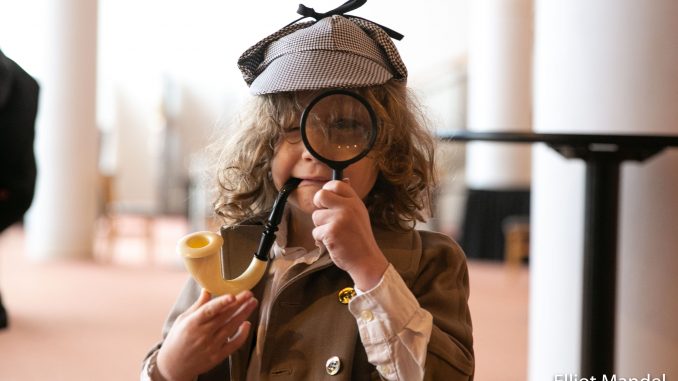
On March 24, 2019 members of the Chicago Philharmonic, performing in ensemble, under the baton of guest conductor/composer Tom Nazziola, presented a program called Silent Sherlock, consisting of 3 silent films with a fresh new score of live music at North Shore Center for the Performing Arts, 9501 Skokie Blvd., Skokie. Participating artists from the Chicago Philharmonic included Robert Hanford, violin; Collins Trier, bass; Jennifer Clippert, flute; Jerry DiMuzio, clarinet; Lewis Kirk, bassoon; Joel Cohen, percussion, and Kay Kim, piano.
Tom Nazziola’s music has been featured on virtually every medium in the world of composition. From live film music to choral and orchestral pieces, his work has been performed and broadcast on radio and television throughout the U.S. and around the world. In addition to composing, Nazziola is also the musical director and orchestrator for the BQE project, a celebrated New York based chamber ensemble known for its original compositions performed live to film.

Nazziola explained that the nature of the performance- the film played with live music- was actually similar to the way audiences had experienced the movies originally. However, in the days of silent films, there might well have been only a piano player, who would most probably have used stock “theme pieces”, such as a romantic theme or a suspenseful theme, which was played depending upon the action on screen. Here, each film was set to specific music Nazziola had composed for the film as a whole. Further, unlike the current “film with score” experiences that are based upon precise computerized timers with “click tracks”, this afternoon the Chicago Phiharmonic musicians were performing without such cues, a much more difficult exercise.
The music for each film did NOT fade into the background, as even the finest scores seem to do when they accompany movies with action, dialogue and soundscapes. Indeed, Nazziola’s compositions modernized, adorned, enhanced and became the focal point of each of the 3 antique pieces, making them more funny, more charming, more relevant.

THE PROGRAM:
1) Sure-Locked Homes featuring Felix the Cat, 1928
The instantly recognizable Felix embodies a “scaredy-cat” or “fraidy-cat” in this wildly witty piece; he is tortured with dread by just about everything he encounters, both outside and inside what he believes to be an empty house. Are shadows really what they seem? Are wild animals or a giant hand actually chasing after him? As he trembles and flees from his pursuers, the music is startled, atonal, ascending and descending, seeming to pant with the feline.
When a shirt, blowing in the wind, having accidentally been released by a Chinese launderer, tangles his heartstrings, the melody escalates and is filled with alarums. Felix escapes with the help of a cunningly articulated spider, set off by clear flute and “popping” percussion sounds, before running to the police for assistance.
2) Fadeaway featuring Koko the Clown, 1926
Created as a “warm-up” to the upcoming Keaton film, BQE crafted its first “cartoon” score to the short, classic film featuring the beloved KoKo the Clown. The short movie is set to Nazziola’s delightful score, incorporating colorful strings and woodwind sensibilities to accent the instrumentation in the storyline which introduces audiences to the art of animation from pencil sketches to fully animated characters.

3) Sherlock Jr. starring Buster Keaton, 1924
In 2005, Time magazine named Sherlock Jr. as one of the All-Time 100 Movies, describing Keaton as “the impeccable comedian…in an impeccable silent comedy”. The film is a quintessentially American deceptively simple seeming piece of genre minimalism. The actions and physical humor are actually surprisingly complex in their combination of romance with sinister criminals, chase scenes, and sparkling with the actor/director’s well-known deadpan wit and slapstick action. The score, too, was rich and lush, period-centric with overtones of 1920’s jazz and swing.
Nazziola advised the audience that, amidst the very funny sight gags, there are many innovative technical accomplishments to watch out for. Also, he explained that Keaton did his own stunts, including the dangerous one where he was hanging off a ladder connected to a huge water basin as the water poured out and washed him onto the railroad track, fracturing his neck. Keaton is said to have suffered from severe migraines for years after making this movie.

Before the films began, and during the intermission, as part of NEXT! In the Foyer, Jack Olin and members of the Actors Gymnasium Teen Ensemble wowed guests with examples of amazing balance and juggling skills.
For information and tickets to all the fine programming of Chicago Philharmonic, go to www.chicagophilharmonic.org
All photos by Elliot Mandel




Be the first to comment